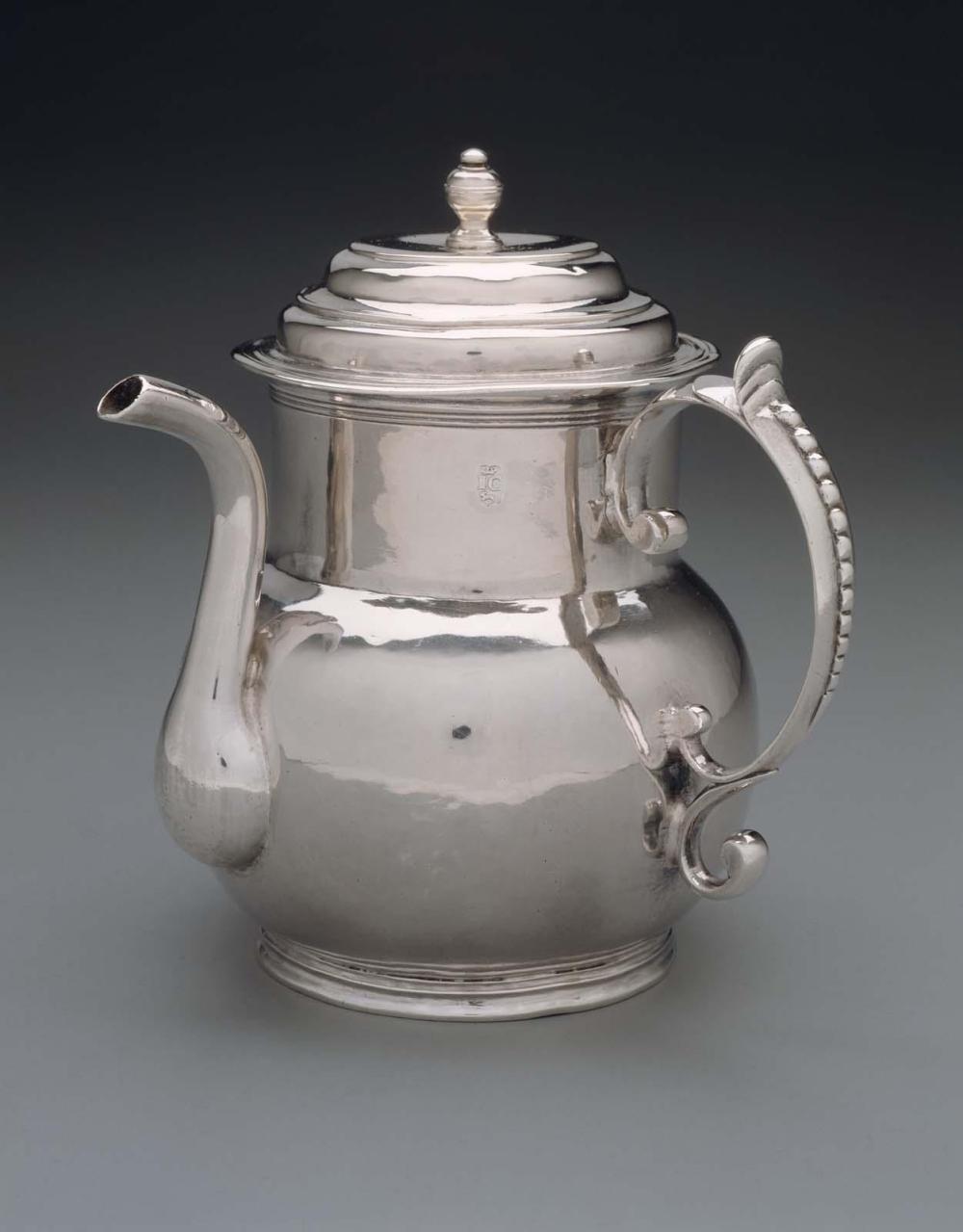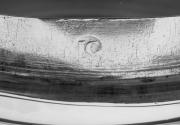Advanced Search
Spout cup
John Coney (American, 1655 or 1656–1722)
1688
Object Place: Boston, Massachusetts
Medium/Technique
Silver
Dimensions
13.8 x 13.3 x 12.4 cm (5 7/16 x 5 1/4 x 4 7/8 in.)
Credit Line
Gift of Cortlandt and James Parker in memory of Major General and Mrs. Cortlandt Parker
Accession Number1991.687
CollectionsAmericas
ClassificationsSilver hollowware
The American spout cup is derived from delft posset pots made in England from the early seventeenth century. These were used to serve posset, a drink of “hot milk curdled with ale, wine, or other liquors, often with sugar, spices, or other ingredients; formerly much used as a delicacy, and as a remedy for colds or other affections.” This form is essentially a caudle cup with two handles and a spout. A two-handled version was made by Jeremiah Dummer; also known are a rare New York example by Jacob Boelen and an unusual, late Philadelphia form by Joseph Richardson.
In America, the form is considered particular to Massachusetts, where it was used primarily between 1690 and 1725 for invalids, women in childbirth, and children. Colonial spout cups may be related to a small number of English examples in silver made in Norwich, Plymouth, and London. In New England, the form was typically lidded to prevent spillage. A very low spout was set at right angles to a single handle. The broad, teardrop base of the spout, similar to those found on posset pots, may have been used to cool liquids before being sipped. Its slender, snaking form clung to the vessel’s body and curved above its rim, enabling the user to drink while reclining.
Many Boston silversmiths during this period were known to have made at least one or two spout cups. The earliest examples by John Dixwell, John Coney, Andrew Tyler, and Jeremiah Dummer were squat vessels having a spherical base, ribbed neck, and friction-fitted lid and were reminiscent of Rhenish forms in clay. But early in the eighteenth century, the fashion shifted toward a Georgian ideal in which the S- curve predominated. Early examples by John Coney include a tall, domed cover, similar to the teapot he made about 1710; his apprentice Nathaniel Morse made at least one similar in appearance. Edward Winslow created a coverless beaker-style cup with a strap handle and spout; his nephew and apprentice Moody Russell re-created this form at least four times. Seven spout cups have been attributed to John Edwards, probably the largest number yet ascribed to a single maker.
William Bowditch was a wealthy mariner from Salem whose large estate included 1451/2 troy ounces of household plate. In addition to the spout cup, a one-handled cup and a gadrooned salver, both by Jeremiah Dummer, were among his family possessions; George Hanners of Boston made eleven gold rings for Bowditch’s funeral in 1728.
This text has been adapted from "Silver of the Americas, 1600-2000," edited by Jeannine Falino and Gerald W.R. Ward, published in 2008 by the MFA. Complete references can be found in that publication.
In America, the form is considered particular to Massachusetts, where it was used primarily between 1690 and 1725 for invalids, women in childbirth, and children. Colonial spout cups may be related to a small number of English examples in silver made in Norwich, Plymouth, and London. In New England, the form was typically lidded to prevent spillage. A very low spout was set at right angles to a single handle. The broad, teardrop base of the spout, similar to those found on posset pots, may have been used to cool liquids before being sipped. Its slender, snaking form clung to the vessel’s body and curved above its rim, enabling the user to drink while reclining.
Many Boston silversmiths during this period were known to have made at least one or two spout cups. The earliest examples by John Dixwell, John Coney, Andrew Tyler, and Jeremiah Dummer were squat vessels having a spherical base, ribbed neck, and friction-fitted lid and were reminiscent of Rhenish forms in clay. But early in the eighteenth century, the fashion shifted toward a Georgian ideal in which the S- curve predominated. Early examples by John Coney include a tall, domed cover, similar to the teapot he made about 1710; his apprentice Nathaniel Morse made at least one similar in appearance. Edward Winslow created a coverless beaker-style cup with a strap handle and spout; his nephew and apprentice Moody Russell re-created this form at least four times. Seven spout cups have been attributed to John Edwards, probably the largest number yet ascribed to a single maker.
William Bowditch was a wealthy mariner from Salem whose large estate included 1451/2 troy ounces of household plate. In addition to the spout cup, a one-handled cup and a gadrooned salver, both by Jeremiah Dummer, were among his family possessions; George Hanners of Boston made eleven gold rings for Bowditch’s funeral in 1728.
This text has been adapted from "Silver of the Americas, 1600-2000," edited by Jeannine Falino and Gerald W.R. Ward, published in 2008 by the MFA. Complete references can be found in that publication.
DescriptionThe spherical body with a molded foot ring rises to a cylindrical neck. An applied lip is scored and slightly everted. The S-scroll spout is affixed over a teardrop-shaped opening in the body. The cast handle has scroll returns at upper and lower points of attachment and a beaded rattail on outer edge, terminating at semicircular thumbpiece. The friction-fitted stepped lid has a button finial.
Marks
To left handle marked "IC" crowned over a coney, within a shield-shaped cartouche. On bezel of lid is stamped"IC" within an ellipse.
InscriptionsInscribed "B / W * M" in roman letters on base. Later script reads "William & Mary Bowditch / Joseph & Sarah Hawthorne / Daniel & Rachael Hawthorne / Simon & Rachael Forrester / Eleanor Forrester. / dau. of Simaon & Rachael Forrester."
ProvenanceProbably be made for William (d. 1728) and Mary Gardner Bowditch (d. 1724) of Salem, who were married in 1688; by descent (1) to Major General Cortlandt Parker (1884-1960); 1936, lent by Major General Parker to the MFA; 1948, returned; 1950, re-lent; 1960, transferred to Mrs. Cortland Parker (Elizabeth Gray) (1886-1969); 1970, transferred to their sons Cortlandt (b 1921) and James (b 1924); 1991, gift of Cortlandt and James Parker to the MFA. (Accession date: Jan 22, 1992)
1: To their daughter Sara Bowditch (1695/96-1761), m.1715 Joseph Hawthorne; to their son, Daniel Hawthorne, m. 1756 Rachel Phelps (about1733-1813); to their daughter, Rachel Hawthorne (1757-1823), m. 1776 Simon Forrester (1748-1817); to their daughter, Nancy Forrester (1793-1881), m/ 1812 Gideon Barstow II (1783-1852); to their daughter, Eleanor Forrester Barstow (1826-1887) m 1854 Caleb Harrison Condit (1826-1881); to their daughter, Charlotte Mathilda Condit (1856-1933), m. Major General James Parker; to their son, Major General Cortlandt Parker.
1: To their daughter Sara Bowditch (1695/96-1761), m.1715 Joseph Hawthorne; to their son, Daniel Hawthorne, m. 1756 Rachel Phelps (about1733-1813); to their daughter, Rachel Hawthorne (1757-1823), m. 1776 Simon Forrester (1748-1817); to their daughter, Nancy Forrester (1793-1881), m/ 1812 Gideon Barstow II (1783-1852); to their daughter, Eleanor Forrester Barstow (1826-1887) m 1854 Caleb Harrison Condit (1826-1881); to their daughter, Charlotte Mathilda Condit (1856-1933), m. Major General James Parker; to their son, Major General Cortlandt Parker.




